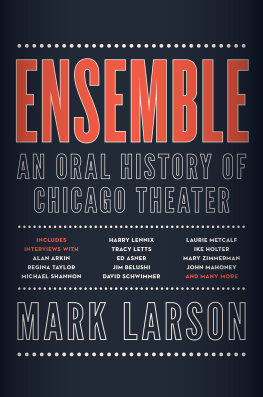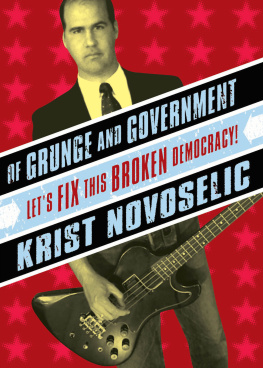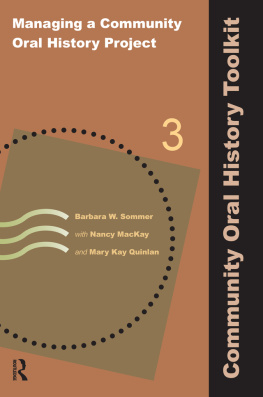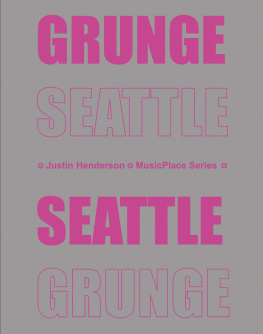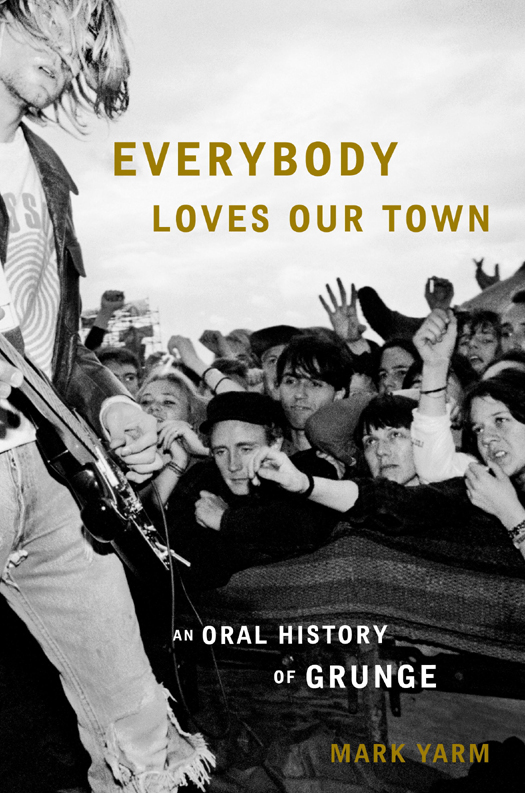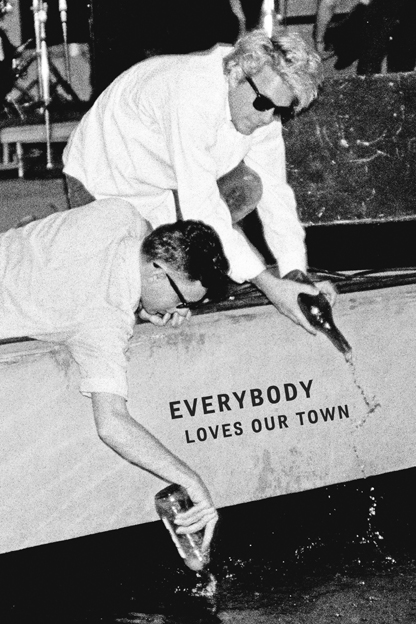
Copyright 2011 by Mark Yarm
All rights reserved.
Published in the United States by Crown Archetype, an imprint of the
Crown Publishing Group, a division of Random House, Inc., New York.
www.crownpublishing.com
Crown Archetype with colophon is a trademark of Random House, Inc.
Frontmatter photos: U-Men roadies Mike Tucker (left) and
Tommy Simpson pouring lighter fluid into the moat, and the
U-Men performing behind a wall of flames, both shot at the Mural
Amphitheatre, Seattle, September 1, 1985; Valerie Broatch
Mudhoney Overblown lyrics on page vii copyright 1992 Better
Than Your Music; used by permission.
The interviews contained herein have been edited for clarity.
Library of Congress Cataloging-in-Publication Data
Yarm, Mark.
Everybody loves our town : an oral history of Grunge / Mark Yarm.
p. cm.
1. Grunge musicUnited StatesHistory and criticism. 2. Grunge
groupsInterviews. I. Title.
ML3534.3.Y37 2011
781.66dc22 2011009192
eISBN: 978-0-307-46445-3
Photo research by Christine Reilly
jacket design by Maria Elias
Jacket photograph by Ed Sirrs
v3.1
To Bonnie and Dad
In loving memory of Clair Yarm
Everybody loves us
Everybody loves our town
Thats why Im thinking lately
The time for leaving is now
Mudhoney, Overblown (1992)
CHAPTER 1:
SOMETHING CRAZYS GONNA HAPPEN
CHAPTER 2:
THE GOSPEL ACCORDING TO BUZZ
CHAPTER 3:
HELLO, SEATTLE!
CHAPTER 4:
THE MOST BEAUTIFUL DANCE
CHAPTER 5:
SCREAMING LIFE
CHAPTER 6:
LEAVING HOME
CHAPTER 7:
A THIRD SOUND
CHAPTER 8:
THE FOUR WEIRDEST GUYS IN ELLENSBURG
CHAPTER 9:
GOING OUT OF BUSINESS SINCE 1988
CHAPTER 10:
SOUNDS LIKE THROW UP LOOKS
CHAPTER 11:
WERE RIPPING YOU OFF BIG TIME!
CHAPTER 12:
TOUCH ME IM SICK
CHAPTER 13:
HE WHO RIDES THE PONY
CHAPTER 14:
BANDS THAT WILL MAKE MONEY
CHAPTER 15:
THE MUSIC BANK
CHAPTER 16:
WHERES THE GROG?
CHAPTER 17:
CREATE YOUR OWN MYTH
CHAPTER 18:
INCOMPATIBLE INDIVIDUALS
CHAPTER 19:
ALL ABOUT KICKS
CHAPTER 20:
SMELL THE MAGIC
CHAPTER 21:
RAISE YOUR CANDLE HIGH
CHAPTER 22:
A BRIGHT, CLEAR SOUND
CHAPTER 23:
GOOD LUCK IN YOUR FUTURE ENDEAVORS
CHAPTER 24:
SICK OF CRYING
CHAPTER 25:
THE FINAL COUNTDOWN
CHAPTER 26:
PUNK BREAKS
CHAPTER 27:
ON THE CORNER OF DOPEY AND GOOFY
CHAPTER 28:
WILD OUTBURSTS IN PUBLIC PLACES
CHAPTER 29:
BILE HOG!
CHAPTER 30:
THE EMPERORS NEW FLANNEL
CHAPTER 31:
THE OLD IMMIGRANTS HATE THE NEW IMMIGRANTS
CHAPTER 32:
STRANGE LOVE
CHAPTER 33:
INTO THE NIGHT
CHAPTER 34:
FUCK HOLLYWOOD!
CHAPTER 35:
A PROBLEM WITH WEIGHTS AND MEASURES
CHAPTER 36:
RADIO FRIENDLY UNIT SHIFTERS
CHAPTER 37:
NOTHING WAS THE SAME
CHAPTER 38:
ALL THE RAGE?
CHAPTER 39:
IN THE ROCKET
CHAPTER 40:
SITTING IN THE RUBBLE
CHAPTER 41:
FUCKING GREAT PRODUCTS
CHAPTER 42:
SOME IMPLODING GOING ON
CHAPTER 43:
THE MAD SEASON
CHAPTER 44:
THE BOYS WITH THE MOST CAKE
CHAPTER 45:
THE COUP
CHAPTER 46:
70 PERCENT OFF ALL FLANNEL
CHAPTER 47:
FELL ON BLACK DAYS
CHAPTER 48:
LOST NINE FRIENDS WELL NEVER KNOW
CHAPTER 49:
MY FRIEND, BUT NOT MY FRIEND
EPILOGUE:
THE COSMIC BROTHERHOOD OF ROCK
First, lets get that word out of the way. Grunge. Yes, this is a book about grunge. The term that bedeviled and, lets face it, benefited (at least temporarily) many a Seattle rock musician in the early to mid-1990s. I cannot count how many times, when I described to an interviewee what exactly it was I was working on, Id get back, I hate that word And here they would go one of two ways: spit out that word grunge or insist, I dont even like to say it, as if uttering that one syllable would somehow validate a now decades-old coinage. (For a thorough, yet inconclusive, probe into how grunge got its name, see .) Others reacted to the term thusly: rubs me raw, a marketing tool, its all just music, fuckin concocted bullshit. And this: When I see the word grunge, especially on books, I kind of goand at this point, the guy I was interviewing made a rather convincing vomiting sound.
Of course, most people dont like to be reduced to a label (retch-inducing or otherwise), particularly when its applied seemingly indiscriminately by the media, as grunge often was after Nirvana broke into the mainstream with Neverminds lead single, the loud-quiet-loud anthem Smells Like Teen Spirit, in fall 1991. As more than one person asked me over the course of my putting this book together, how is it that a band like Pearl Jama well-polished musical outfit whose sound owes more to classic rock than punk rockwas labeled grunge, a word that evokes scuzzy guitar tones and all-around rawness? The answer, it would seem, comes down to genealogy (two of Pearl Jams members come from what many cite as the first grunge band, Green River) and, more simply, geography (they are, after all, from Seattle). If you lived in Seattle and were under 30 at that point, you were grunge, is how Ben London, who fronted the not particularly grungy Seattle band Alcohol Funnycar, described the early 90s to me. Though in short order, the term would transcend geography, being applied to the Stone Temple Pilots (from San Diego), Bush (the U.K.), and Silverchair (Australia), all multiplatinum, corporate rock bands accused of jumping on the grunge bandwagon.
We could argue foreverand people on Internet message boards doabout what bands are grunge, because the label is entirely subjective. Are Alice in Chains grunge or heavy metal or both? Were 7 Year Bitch punk or grunge or Riot Grrrl? How about contemporary Canadian arena rockers Nickelback: Post-grunge? Neo-grunge? But with the passage of time, some in the Seattle music community have come to grudgingly accept the g-word. We never considered anybody to be grunge, guitarist Steve Turner of Mudhoneythe band whose raw, scabrously funny single Touch Me Im Sick epitomizes the so-called Seattle soundtold author Clinton Heylin a number of years back. In 1995, we came out of the closet and said, Fine, were grunge. If anybody fuckin is, we are.


